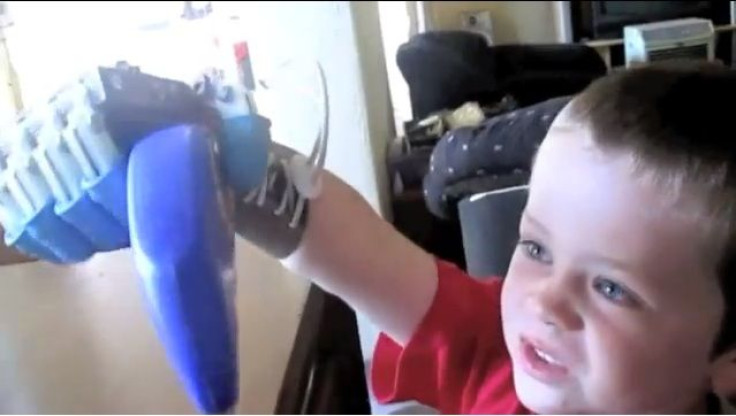Mechanical Prosthetic Hand Developers Release Design To Public Domain [VIDEO]

The creators of a robotic prosthetic hand have made the design public domain for anyone with a 3-D printer to use, reports Ars Technica. The two researchers, Ivan Owen of Washington state and Richard Van As of South Africa, collaborated in 2012 to design and build a prosthetic hand for a five-year-old boy named Liam. Now they hope their work may help anyone who needs a prosthetic hand.
Liam was born with Amniotic Band syndrome, which caused amputation of the fingers on his right hand before birth, Ars Technica says. Using open source software and a 3-D printer, the two researchers built Liam a series of prosthetic hands. The final product is called the Robohand, a mechanical hand prosthetic that could cost less than commercial prosthetics. Owen and Van As have made the design available to all for free, in order to help others who need prosthetics but can't afford them, Ars Technica says.
Van As first contacted Owen after he saw a video of Owen demonstrating a mechanical hand he made in 2011 for a science fiction convention. Van As had been trying to design mechanical finger prosthetics for himself after a woodworking accident left him with a maimed right hand, Ars Technica says. Van As had been told conventional prosthetics could cost him at least $10,000 per finger.
Working long distance, the two men collaborated on designs and prototypes. They had planned to meet in November to finish the design for Van As' prosthetic, but they were contacted by Liam's mother, who had seen their project online and asked them to help her son, Ars Technica says. "When [Van As] was contacted by [Liam's mother] Yolandi, we decided we would have a go at trying to build an initial prototype for Liam in the space of time that I was there as well. We only had 3 and a half days, so, you know, it was an arduous task, but it was something we felt we should definitely do while we were in the same place at the same time," Owen tells Ars Technica.
Liam got his first prototype hand in November, and with the help of two donated 3-D printers, Owen and Van As were able to improve on the design and rapidly construct new prototypes, until they finally hit on the right design. Liam received his finalized hand in February. Owen tells Ars Technica that the speed with which the printers have been able to produce parts has allowed him and Van As to make rapid improvements to each iteration of the Robohand.
And as Liam grows, Ars Technica adds, the hand's design can be scaled up and reprinted to grow with him.
Owen tells Ars Technica he hopes the design can be used to help U.S. veterans who have lost fingers or hands in combat. "I live not too far from Seattle, and [we] have Joint Base Lewis McChord near us," he says. "I would like to talk to on-base occupational therapists. If they have the funding to get a 3-D printer, they could work with this." And because the design is public domain, he adds, the cost to produce each prosthetic would be very low since no one would have to pay royalties.



























